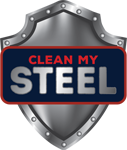Stainless Steel 101
Posted by Eric Goldman on
Stainless steel is a popular material used for various appliances in modern homes, from refrigerators to dishwashers and ovens. However, not all stainless steel is created equal. In this blog post, we'll explore the different grades of stainless steel used in today's appliances and explain why a magnet sticking to the steel is a sign of lower quality. We'll also look at why home appliance stainless steel bought at big box stores is often inferior to better quality stainless steel.
First, let's talk about the different grades of stainless steel used in appliances. There are several grades of stainless steel, each with its own unique properties and applications. The most common grades used in appliances are 304, 316, and 430. 304 is the most commonly used grade, known for its strength and resistance to corrosion. 316 is a higher-grade steel that is more resistant to corrosion and is often used in marine applications. 430 is a lower-grade steel that is less expensive and less resistant to corrosion.
One way to tell the quality of stainless steel is to use a magnet. If a magnet sticks to the steel, it is not a high-quality stainless steel. This is because high-quality stainless steel contains more nickel, which makes it non-magnetic. Lower-grade stainless steel, like 430, contains less nickel, making it magnetic.
So why is home appliance stainless steel bought at big box stores often inferior to better quality stainless steel? The answer is simple: cost. Lower-grade stainless steel is less expensive to produce, so appliance manufacturers often use it to keep costs down. Unfortunately, this means that appliances made with lower-grade stainless steel may not last as long or perform as well as those made with higher-quality stainless steel.
Inferior stainless steel appliances may also be prone to rust and corrosion, which can be unsightly and even dangerous. In addition, lower-quality stainless steel may be more difficult to clean and maintain, as it may be more prone to scratches and other damage.
In conclusion, when shopping for stainless steel appliances, it's important to consider the grade of stainless steel used. Look for appliances made with high-quality stainless steel, such as 304 or 316, which will be more resistant to corrosion and last longer. And remember, if a magnet sticks to the steel, it's not a high-quality stainless steel. By investing in higher-quality stainless steel appliances, you can ensure that your appliances will last longer and perform better, saving you time and money in the long run.
Share this post
- 0 comment
- Tags: best stainless steel cleaner, best stainless steel rust remover, clean my stainless steel, clean stainless steel, Stainless Steel Protection, Stainless Steel Rust Protection
